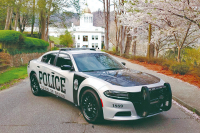The lamentable loss of Appalachian yard junk
By Brent Martin
The most popular subject of conversation in mountain communities today deals with the hollows and ridge tops of Appalachia being filled to capacity with gated and mysterious wealth.
Many of the people who live at or visit these places a few weeks per year apparently have no ability to understand the changes they are inflicting upon one of the most ancient landscapes on earth. While most of these changes deal with the loss of farm and forestland, there are others that bear equal weight in the mind of many. These changes involve the destruction of rural culture and character, a complex system of traditions and values that the gated wealth cannot comprehend nor desire to.
One such tradition that quickly raises the hackles of these squeaky clean suburbanites is the abandonment of old cars and machinery in yards, as well as the perceived disregard for keeping up appearances when it comes to such urban concepts as landscaping. Yet, for an outsider such as myself, these practices for me are what make much of the old Appalachian landscape interesting. I like the settled appearance of an old Appalachian homestead — the utility of things such as buckets, metal siding, car seats, half fallen barns full of firewood. I like chickens running around a yard, the lived in-ness of a place that is defined by the years of accumulated debris and rusted out machinery.
To illustrate, Macon County where I live in Western North Carolina recently attempted the adoption of certain ordinances to regulate noise, junkyards, machinery, and road signs. At one of the many hearings, the junkyard ordinance was brought up for discussion. The packed room held a mixture of multi generational locals, second homeowners, and people like me — people who now live here full time but had moved here from somewhere else. Many rose to the defense of the ordinance, citing specific examples of how junk and junkyards were desecrating their views and hallowed commutes to the local Wal-Mart. A stocky late middle-aged woman from the Burningtown community rose to complain of a junkyard that dominated several acres along the single road running the length of one of the area’s most spectacular valleys. Little did she know that the owner was seated almost directly in the row behind her.
He rose slowly, speaking calmly and deliberately. “My neighbors tell me that they’ll take my junkyard any day over a hillside of half-million dollar mansions.” The Floridian rose quickly to let him know what an eyesore the place was. “Well, it’s been in my family for over 50 years, long before you came here to start ripping the place up with all your fancy houses.” Silence.
It was hard not to agree. I had lived in Burningtown for a year and a half when I first moved to Macon County and was fortunate to live among a local family that I had grown to respect greatly. I watched for 18 months as the remaining large tracts of land sold to out-of-state developers who gouged roads into mountainsides and razed the ridge tops for million dollar views. I’ll take the junkyard.
At another community event, one of the many newcomers I live near complained of a single-wide trailer that sat at the end of the gravel road I live on. A couple of old cars sit out front and a band of ragtag goats drift about the adjacent pasture. The roof is in need of repair and an old rusty swingset sits out in an unkempt yard. The field behind her has an old bus in it, a couple of dilapidated sheds, and a well-used garden site. She was concerned about property values — really, not an issue here, since the only direction they are going is up — and what an assault it was upon a variety of her middle-class values. I happened to know that a single working class mother of two lives in the trailer she was referring to. Maybe this particular newcomer could host a fundraiser to buy her some Bradford Pear trees. A new roof would probably be out of the question. Regardless, these attitudes along with the pruning up and landscaping of Appalachia, is changing the character of the place, and, in my opinion, for the worse.
For years I have also heard people complain of the junk dumped off of old roads in secluded locations — popular spots where old washing machines, refrigerators, automobiles, tires, and garbage thrown down hillsides accumulates for sometimes decades. Granted, many of these sites are eyesores and can even be toxic, but when wandering among the piles of debris I am always mystified and feel that I am witness to an accumulation of artifacts of past lives, families, and culture. And after having lived and worked now in Appalachia for more than 12 years, and having descended from mountain people in Georgia who lived hardscrabble lives, it is my conclusion that much of this junk dumped in this fashion was done so because there was simply no place else to take it.
Landfills in these rural counties have only arrived in the last few decades, and then only because so many outsiders moving here needed a designated place to take their massive amounts of waste, as they could never bring themselves to throwing all that unwanted stuff out at roadside. The mountain culture here for many years utilized everything — car seats made comfortable front porch furniture, glass jars could be used multiple times for canning food, old tires made excellent swings, old cars were kept around for parts, and none of it was necessarily considered trash.
The old roadside trash dumps that still exist in this county today are some of the most interesting places left, and represent a time and a place when such practices could be allowed without condemnation or need for apology. They also represent unconquered space, for if they exist, they have not been surrounded by or covered over by gated communities or golf courses, nor have their neighbors gotten near enough to feel the need to organize a clean up. One such place exists along a lonely stretch of state highway 28 that runs from the Macon County line into Swain County. Just before a place in the road where Brush Creek runs beneath it into the state-owned Needmore Gamelands, it covers a large area of hillside that runs a few hundred feet down to the creek bank.
This past fall I was fortunate to spend several weeks with a local scientist studying the fall migrations of certain shiner species up this tributary to the Little Tennessee River, and found myself many times stopped at this location as we counted fish shocked up with a backpack shocker, or ate a quiet lunch on the banks of this rugged mountain stream.
I studied the hillside noting the numerous tractor tires, washing machines, mattress springs, rusted out washtubs, broken mason jars, and refrigerators. It was the most remote part of the county left, and just up the creek were families that had been here since the Cherokee removal and who were probably responsible for much of what was there. None of it was modern, and none of it was from recent years. The junk was settled among ancient moss covered boulders and seemed mysterious and not at all out of place. It spoke of times past and represented the transformation of a people — much like the rest of modern America — into an appliance dependent culture with no place to discard the disposable metal carcasses upon their demise.
Of course, these were a people who for many years had derived their existence from the natural world around them. For me, this pile of junk was a symbol of the shift from independence to dependence for mountain people, and the current sanitization of the countryside by the second homeowners was just another part of their cultural eradication process. And the practice of flinging the stuff off the roadside has led to the further stereotyping of Appalachians as being backwards and uncivilized.
One close friend even remarked to me that she believed that the multi-generational local people who had been here for the last 200 years had no land ethic, and she used the old roadside dumps as evidence. Her hackles were up over the fact that we had no land-use planning in our county and that our weak stream protection laws were not being enforced.
It is true that there is a strong county contingent that cites private property rights at every opportunity, and a good many of them are local, but they are populated equally with out-of-state developers and crackpot philosophers of every stripe. What she has not seen and will never see is history, which speaks quietly in these mountains and which must be teased out of the landscape with gentle interpretation.
However, perhaps history will judge the current destruction of the southern Appalachians to be part of one of the most uncivilized and unregulated movements in American history. The industrial loggers and mineral extractors of the late nineteenth and early twentieth centuries razed the mountains for timber, coal, iron, and labor, and in many places are still at it, but a host of progressive-era federal agencies such as the Forest Service and National Park Service were able to recover and restore a good bit of the decimated land through reforestation and preservation. The Civilian Conservation Corps put thousands of mountain people to work in the 1930s building campgrounds, restoring streams, planting trees, and stocking trout. The few old mountain people I know who remember these days are proud of this work, proud of the once controversial Great Smoky Mountains National Park, and proud of their old farmsteads and land. The removal or restoration of a Wal-Mart parking lot or a ridgeline full of houses will never stand such a chance.
(Brent Martin is a Franklin resident who can be reached at This email address is being protected from spambots. You need JavaScript enabled to view it..)





